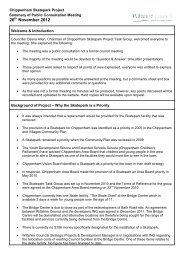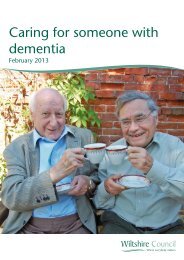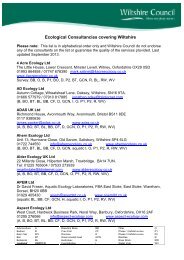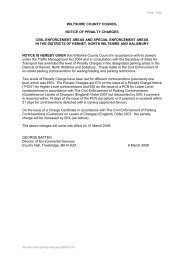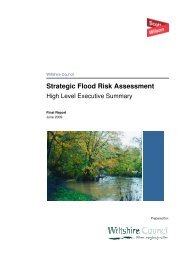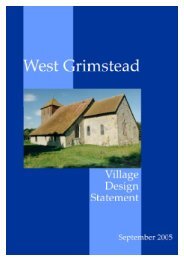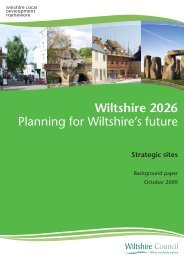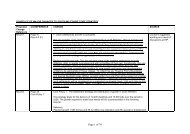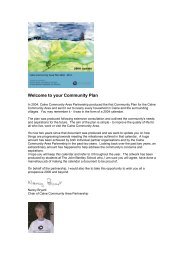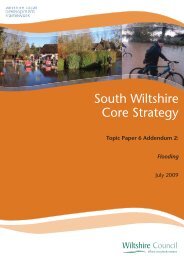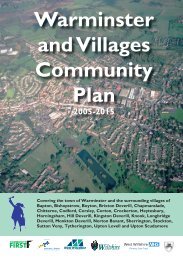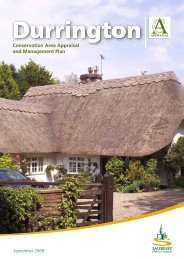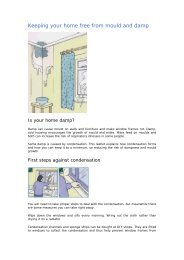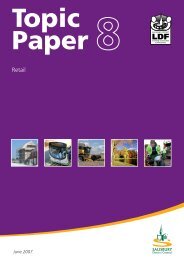Matter 11 Core policy 9 - Wiltshire Council
Matter 11 Core policy 9 - Wiltshire Council
Matter 11 Core policy 9 - Wiltshire Council
You also want an ePaper? Increase the reach of your titles
YUMPU automatically turns print PDFs into web optimized ePapers that Google loves.
<strong>Wiltshire</strong> Local<br />
Development<br />
Framework<br />
South <strong>Wiltshire</strong><br />
<strong>Core</strong> Strategy<br />
<strong>Matter</strong> <strong>11</strong><br />
<strong>Core</strong> <strong>policy</strong> 9<br />
Old Sarum Airfield<br />
Ref: DJM/SWCS/M<strong>11</strong><br />
January 2010
Leave Blank<br />
2
Contents<br />
Issues and <strong>Matter</strong>s to be Considered<br />
Question <strong>11</strong>.1. Potential Areas for Development. On what<br />
basis were the potential areas for development shown on Map 5<br />
selected. In particular what assessment has been made of the<br />
potential effect, positive or negative, that developing these areas<br />
would have on the setting of The Old Sarum Airfield Conservation<br />
Area, of listed buildings within that area and of the Old Sarum<br />
Scheduled Ancient Monument<br />
Question <strong>11</strong>.2. Aircraft Noise. What potential would the<br />
development of these sites have to secure some control over the<br />
noise of aircraft using the airfield<br />
Page No.<br />
5<br />
6<br />
3
Leave Blank<br />
4
Question <strong>11</strong>.1. Potential Areas for Development. On what basis were the<br />
potential areas for development shown on Map 5 selected. In particular what<br />
assessment has been made of the potential effect, positive or negative, that<br />
developing these areas would have on the setting of The Old Sarum Airfield<br />
Conservation Area, of listed buildings within that area and of the Old Sarum<br />
Scheduled Ancient Monument<br />
1.0 Areas shown on Map 5 were selected, firstly, because they would not<br />
prejudice the historic flying activity, at the airfield. The unsevered relationship<br />
between the listed hangars and the operational flying field is a unique feature<br />
as indentified in the English Heritage study, 'Survey of Military Aviation Sites<br />
and Structures, Summery Report' by the Thematic Listing Programme, J.<br />
Lake 2000 (see evidence base document STU/49).<br />
1.1 Secondly they were based on an assessment of the site to establish how the<br />
topography could be utilised to introduce carefully screened views both in and<br />
out of the site and across the airfield, thereby mitigating the impact of later<br />
commercial built interventions. The Old Sarum Conservation Area Appraisal<br />
is a detailed assessment of the airfield and its environs, the first step of which<br />
was the production of the document, 'Old Sarum Airfield Character Appraisal<br />
and Assessment of Eligibility for Conservation Area Designation' August<br />
2006, by Atkins (see evidence base document STU/43). This document<br />
clearly indicates (page 32) where there have been instances of intrusion and<br />
damage to the special qualities of Old Sarum Airfield. Page 36 of the same<br />
document outlines the potential for enhancement, through improved<br />
landscaping and restoration of items of original character, through removal of<br />
inappropriate fences and such like. This data was drawn on by the landowner<br />
who commissioned their own detailed contextual landscape and site appraisal<br />
to further inform discussions with the <strong>Council</strong>. .<br />
1.2 Based on such evidence it is the assessment of the <strong>Council</strong> that carefully<br />
designed development has the potential to have a positive effect on the<br />
airfield, listed buildings and Old Sarum Scheduled Ancient Monument,<br />
through the greatly improved screening of inappropriate views, through<br />
careful design and a comprehensive landscape scheme. Also, as outlined at<br />
page 36 of the Atkins Study, some interpretative material and managed public<br />
access to the site would greatly add to the understanding and appreciation of<br />
the airfield and its role in British aviation history.<br />
1.3 South <strong>Wiltshire</strong> <strong>Core</strong> Strategy Final Sustainability Appraisal July 2009<br />
Appendix IV, page 151-153 indicates a positive outcome for this proposal<br />
subject to appropriate mitigation measures.<br />
1.4 At the Full <strong>Council</strong> meeting on 10 November 2009, <strong>Wiltshire</strong> <strong>Council</strong> resolved<br />
to submit the <strong>Core</strong> Startegy with the revision, raised intially by the local<br />
<strong>Council</strong>lor, that the area shown on Map 5, to the south of the airfield be<br />
deleted. This revision is subject to change highlighted in Schedule<br />
SWCS/13B, 'Changes to the South <strong>Wiltshire</strong> <strong>Core</strong> Stratgey Submission<br />
Document'. <strong>Council</strong>lors expressed a concern over the impact of new<br />
residential development in this particular area on the separate identity and the<br />
amenity of the residents of the village of Ford. This proposed change has<br />
been subject to consultation and Sustainability Appraisal, which concludes it<br />
may have a positive effect in that it removes development from a settlement<br />
5
that is not seen as sustainable in the settlement hierarchy and protects open<br />
space.<br />
Question <strong>11</strong>.2. Aircraft Noise. What potential would the development of<br />
these sites have to secure some control over the noise of aircraft using the<br />
airfield<br />
2.0 <strong>Core</strong> Policy 9, seeks to afford the <strong>Council</strong> some control over the level of flying<br />
activity and therefore the noise caused by it, for the first time. This would be<br />
by means of a voluntary, but enforceable, Section 106 Agreement that sets<br />
out the type and levels of flying activity that would be permitted. The<br />
background to this is important.<br />
2.1 The Local Authority has been seeking a means of controlling flying activity for<br />
many years, to strike a balance between a locally important leisure activity,<br />
which acts to preserve the historic use of the airfield, and the amenity of<br />
nearby residents. In response to ongoing complaints over the noise the<br />
<strong>Council</strong> has considered a number of measures including:<br />
• Environmental Health regulations<br />
• Enforcement Action<br />
• Seek changes to National Legislation.<br />
• Local Plan Policies<br />
• Discontinuance Order<br />
• Voluntary partnerships through the Flying Club Forum.<br />
With the exception of the latter, which has been helpful due to the positive<br />
engagement by the Flying Club, the search has been fruitless.<br />
2.2 The main issue being that when planning permission was granted for a<br />
change of use from military to civilian airfield in 1982, no conditions were<br />
imposed to control the use, and hence the owners have unrestricted flying<br />
rights. This includes potential night flying and continuous training circuits.<br />
While the operator has been responsible, there are occasions when<br />
intensification of flying, especially during the summer months, has led to<br />
peaks in complaints.<br />
2.3 The landowner has expressed a commitment to explore a voluntary Section<br />
106 agreement which sets out the type and levels of flying that will be<br />
undertaken. This would allow the <strong>Council</strong>, for the first time, to have some<br />
control over the activities so that it can monitor and enforce if, for example,<br />
the activity intensifies in a manner that is outside the agreed parameters and<br />
leads to a high level of complaints.<br />
6



